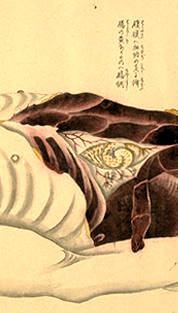Fukufukushi

A lot of Japanese medical terminology is actually Sino-Japanese: whether imported from mainland China or invented here, the morphemes used are of Chinese rather than Japanese origin. In particular, almost all of the organs have Sino-Japanese names, and the exceptions like kimo ("liver") and harawata ("guts") carry so much synecdocheic and metaphorical baggage that they are basically useless for medical purposes.
But people have been hunting and cutting up animals out here on the archipelago much longer than they have been learning Chinese, and their native vocabulary of words for internal organs was surprisingly rich, given how entirely it was abandoned in favor of a more prestigious and specific Sino-Japanese substitute.
(Acknowledgment: This list of examples comes from Ōno Susumu's Nihongo Sōdan.)
- Lungs (MJ: hai, 肺) were called fukufukushi, maybe related to fuku ("blow", "breathe", etc.) and/or fukureru ("swell") and/or fukuro ("bag").
- The spleen (MJ: hizō, 脾臓) was called the yokoshi, maybe because it is to the side (yoko) of the liver/stomach blob?
- The large and small intestine (MJ: daichō, 大腸, and shōchō, 小腸) were the harawata ("belly wata")/ōwata ("big wata") and hosowata ("skinny wata"). Wata may be related to the wata that means "cotton". Note that harawata as a word is still around, although now as then it can also mean "guts" or "sub-stomach digestive system in general".
- The stomach (MJ: i, 胃) was also known as the kusobukuro ("shit bag"), although again this term could apply to the entire digestive system. (Kusowata, "shit wata", was another of the general wata terms.) In Donkey-Saddle Bridge (驢鞍橋), SUZUKI Shōsan famously said that to "discard this bag of shit" (i.e. body) without regret or hesitation was the essence and indeed entirety of Buddhism ("後世を願うというは、この糞袋を何とも思わず打ち捨てること也。ここを仕習うより別の仏法を知らず"), but I am not sure if this usage can claim direct descent from the word meaning "stomach" or whether it was invented anew out of contempt for the body in general.
- On that note, the bladder (MJ: bōkō, 膀胱) was the yubaribukuro ("piss-bag"). Yubari is from yumari, yu (warm water) + mari (evacuation). (The verb maru is obsolete now, but it appears in Manyōshū poem #3832: kura tatemu/ kuso tohoku mare, "I'm going to build a shed/ Do your business far away from it".)
![[No-sword]](http://no-sword.jp/images/site/no-sword_banner.jpg)



R:
great post. I can't wait to say 糞袋がすいた